
Zork is a text-based adventure game first released in 1977 by developers Tim Anderson, Marc Blank, Bruce Daniels, and Dave Lebling for the PDP-10 mainframe computer. The original developers and others, as the company Infocom, expanded and split the game into three titles—Zork I: The Great Underground Empire, Zork II: The Wizard of Frobozz, and Zork III: The Dungeon Master—which were released commercially for a range of personal computers beginning in 1980. In Zork, the player explores the abandoned Great Underground Empire in search of treasure. The player moves between the game's hundreds of locations and interacts with objects by typing commands in natural language that the game interprets. The program acts as a narrator, describing the player's location and the results of the player's commands. It has been described as the most famous piece of interactive fiction.

Beyond Zork is an interactive fiction computer game written by Brian Moriarty and released by Infocom in 1987. It was one of the last games in the Zork series developed by Infocom. It signified a notable departure from the standard format of Infocom's earlier games which relied purely on text and puzzle-solving: among other features, Beyond Zork incorporated a crude on-screen map, the use of character statistics and levels, and RPG combat elements.
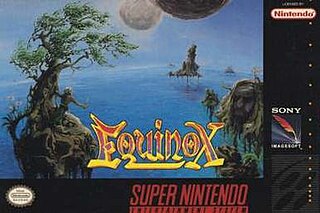
Equinox is an action adventure puzzle video game developed by Software Creations and published by Sony Imagesoft for the Super NES. A sequel to Solstice (1990) for the Nintendo Entertainment System, Equinox depicts Glendaal saving his father, the predecessor's playable character Shadax, from the imprisonment of Sonia, Shadax's apprentice. The player acts as Glendaal, exploring 458 rooms in eight underground dungeons. The player collects 12 blue orb tokens while solving puzzles, killing enemies, collecting keys, navigating platforms and blocks, and battling bosses. It continues Solstice's isometric puzzle game style, with greater emphasis on action adventure and Mode 7 overworld map.
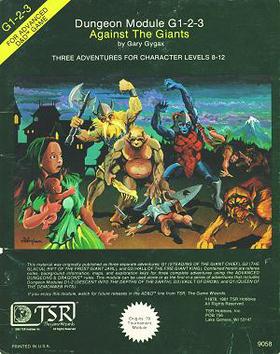
Against the Giants is an adventure module written by Gary Gygax and published by TSR in 1981 for the Dungeons & Dragons fantasy role-playing game. It combines the G series of modules previously published in 1978: Steading of the Hill Giant Chief, Glacial Rift of the Frost Giant Jarl, and Hall of the Fire Giant King. All three were produced for use with the 1st edition Advanced Dungeons & Dragons rules. In 1999, to recognize the 25th anniversary of TSR, the company released an updated version, Against the Giants: The Liberation of Geoff. Later in 1999, Wizards of the Coast published a novelization of Against the Giants by Ru Emerson.
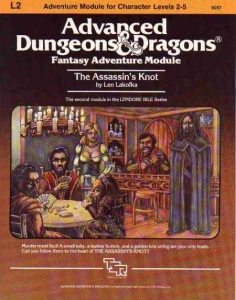
The Assassin's Knot is an adventure module written by Lenard Lakofka for the first edition of Advanced Dungeons & Dragons and published by TSR in 1983. It is designed for 6 to 10 novice and intermediate players with characters of levels 2-5.

The Hidden Shrine of Tamoachan is an adventure module for the Dungeons & Dragons (D&D) fantasy role-playing game, set in the World of Greyhawk campaign setting for use with the 1st edition Advanced Dungeons & Dragons rules. It is the first in the C-series of modules, a set of unrelated adventures originally designed for competitive play, with the C representing the first letter in the word competition.

Dungeon! is an adventure board game designed by David R. Megarry and first released by TSR, Inc. in 1975. Additional contributions through multiple editions were made by Gary Gygax, Steve Winter, Jeff Grubb, Chris Dupuis and Michael Gray. Dungeon! simulates some aspects of the Dungeons & Dragons (D&D) role-playing game, which was released in 1974, although Megarry had a prototype of Dungeon! ready as early as 1972.
Escape the room, also known as room escape or escape game, is a subgenre of point-and-click adventure game which requires a player to escape from imprisonment by exploiting their surroundings. The room usually consists of a locked door, objects to manipulate, and hidden clues or secret compartments. The player must use the objects to interact with other items in the room to reveal a way to escape. Escape the room games were born out of freeware browser games created in Adobe Flash, but have since become most popular as mobile games for iOS and Android. Some examples include Crimson Room, Viridian Room, MOTAS, and Droom. The popularity of these online games has led to the development of real-life escape rooms all around the world.

Book of Challenges is a supplemental rulebook for the 3rd edition of the Dungeons & Dragons role-playing game that presents a number of ready-made dungeon encounters that a Dungeon Master can insert into a scenario.
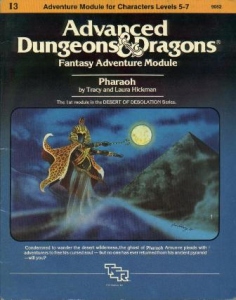
Pharaoh is an adventure module for the Dungeons & Dragons fantasy role-playing game. The module was published in 1982 by TSR, Inc. for the first edition Advanced Dungeons & Dragons rules. It formed the first of the three-part Desert of Desolation module series. The module was written by Tracy and Laura Hickman; Tracy Hickman would later go on to help create the Dragonlance campaign setting.
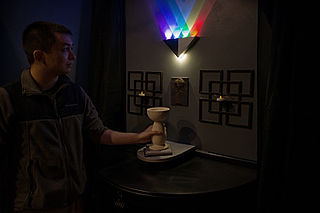
An escape room, also known as an escape game, puzzle room, exit game, or riddle room is a game in which a team of players discover clues, solve puzzles, and accomplish tasks in one or more rooms in order to accomplish a specific goal in a limited amount of time. The goal is often to escape from the site of the game. Most escape games are cooperative but competitive variants exist. Escape rooms became popular in North America, Europe, and East Asia in the 2010s. Permanent escape rooms in fixed locations were first opened in Asia and followed later in Hungary, Serbia, Australia, New Zealand, Russia, and South America.
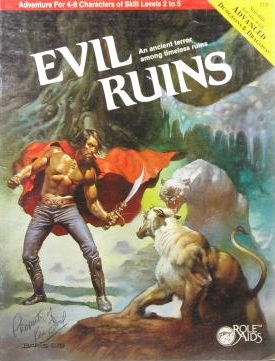
Evil Ruins is an adventure for fantasy role-playing games published by Mayfair Games in 1984.

Sword of Hope is an adventure for fantasy role-playing games published by Judges Guild in 1980.

The Dungeon of the Bear is a 1979 role-playing game adventure for Tunnels & Trolls written by Jim "Bear" Peters and published by Flying Buffalo. Originally published as three separate booklets these were combined with an entrance-level and republished in 1982 as "The Complete Dungeon of the Bear". A referee is required to play.
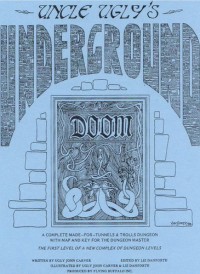
Uncle Ugly's Underground is a 1978 role-playing game adventure for Tunnels & Trolls published by Flying Buffalo. It was written by Ugly John Carver. Although described on the cover as "The first level of a new complex of dungeon levels." to date only Level 1 has been released. A referee is required to play.
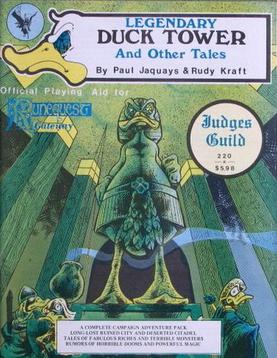
Legendary Duck Tower is a 1980 fantasy role-playing game adventure published by Judges Guild.

The Toughest Dungeon in the World is a 1980 role-playing game solo adventure for Tunnels & Trolls.
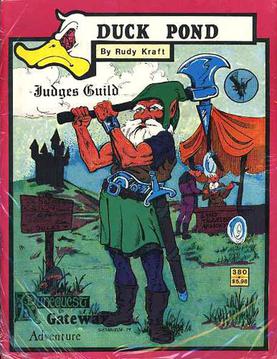
Duck Pond is a 1980 fantasy role-playing game adventure published by Judges Guild.

ClueKeeper is a GPS location-aware software platform created by a group of puzzle lovers and initially released in 2013. It is an iOS and Android based app for building and playing puzzle hunts. It incorporates features of a puzzle hunt, an escape room, and augmented reality.

Dargon's Dungeon is a 1977 adventure published by Flying Buffalo for Tunnels & Trolls.



















